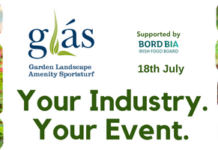

In this newsletter we have information on:
1. Invasive Species Ireland Forum 2012
2. Be Plant Wise
3. Himalayan balsam bash 2012 – get involved
4. National Invasive Species Database
5. Invasive Species Alert Tracking Table
6. SIMBIOSYS project final conference
7. Economic impact assessment
8. News from the GB Non-native Species Secretariat
9. New website to help ID crayfish
10. Report your sightings
11. EU Directive consultation
12. NEOBIOTA 2012
13. Projects Database
14. Find us on Facebook
1. Invasive Species Ireland Forum Registration now open
The Sixth Annual Invasive Species Ireland Forum will take place on the 3rd of May. The National Botanic Gardens, Glasnevin, will host the 2012 Forum. The forum programme will include an update from Invasive Species Ireland and talks covering the freshwater, marine and terrestrial environments. Confirmed talks include:
- Preliminary results from the invasive species economic impact assessment for Ireland and Northern Ireland – Anthony Jackson
- Trends and introductions of invasive species – Colette O’Flynn
- Update on the current status of the Ballast Water Convention – Tracey McCollin
- An analysis of marine pathways in the UK and Ireland – Paul Stebbing
- Muntjac and Sika in Ireland – Ruth Carden
There will also be at least two break out groups:
- EU Strategy – gathering views of trade and industry
- Local Action Groups – identifying needs and support mechanisms
More information will be made available in the coming weeks. Registration is currently open. Please register using the form available at:
or contact John Kelly directly by replying to this email or john@invasivespeciesireland.com.
Please note that registration will close on Friday the 27th of April.
As with previous years, this is a free event but attendees must register with the project team before hand.
2. Be Plant Wise
The Be Plant Wise campaign was formally and publicly launched in both Northern Ireland and Ireland on the 08 March 2012. In Northern Ireland, Mr. Alex Atwood MLA, the Minister for Environment, launched the campaign. In Ireland, Mr. Jimmy Deenihan T.D., Minister for Arts, Heritage and the Gaeltacht launched the campaign.
The key messages in the campaign are:
- Know what you grow,
- Stop the spread, and
- Compost with care.
Materials have been developed for display in garden centres. If you know of a garden centre that wants these materials please get in touch by emailing john@invasivespeciesireland.com. You can find more information on the campaign on the following link:
The launch was supported with press releases for both Northern Ireland and Ireland:
Be Plant Wise Trail
The National Botanic Gardens, Glasvenin, has established a Be Plant Wise Trail. The plants featured are garden plants that are known to invade habitats in Ireland. The labels feature pictures of the places they have invaded, along with a quick identification guide to the plants themselves. Find out more:
3. Himalayan balsam bash 2012 – get involved Invasive Species Ireland is supporting Himalayan Balsam Bash 2012. This is an initiative designed and run by Inland Fisheries Ireland as part of Fisheries Awareness Week.
Himalayan balsam can take over large areas of river bank or damp habitat. As well as causing problems for native species, Himalayan balsam substantially increases the risk of riverbank erosion. It does this by stopping native bank side vegetation growing. The roots of these natives would bind the banks. With just balsam in the autumn, when it dies it leaves only bare soil that is easily eroded and washed away by rain or flood events.
During Fisheries Awareness Week (12 – 20th May ’12) Inland Fisheries Ireland will be running a number of ‘Balsam bashes’. Details have yet to be finalised. More information can be found on the following website:
If you want to organise your own Balsam Bash send us your details on this form:
4. National Invasive Species Database
Species browser
Have you taken a look at the Species Browser on the National Invasive Species Database? You can find a wealth of information including the date of first record, identified pathways of introduction, habitat data and recorded distribution of many non-native and invasive species.
More information is available on the following link:
Spot the Alien
‘Spot the Alien’ has been re-launched for 2012. The Spot the Alien project was set-up to increase awareness of invasive species and to encourage reporting of them with an initial focus on 3 species:
- New Zealand flatworm
- Harlequin ladybird
- Red lily beetle
These species are often introduced into Ireland as ‘hitch-hikers’ in plant or garden products so please check all potted plants, flowers, compost and vegetable produce before purchase if possible.
5. Invasive Species Alert Tracking Table
Issuing an Invasive Species Alert is a key part of the early warning and rapid response to a new invasive species incursion. The purpose of issuing an invasive species alert is:
- To notify the public and stakeholders of the incursion of a new invasive species.
- An alert is a part of the triggering mechanism for rapid response to a new invasive species.
- To inform the public on what action may be required e.g. preventing further releases.
- Encourage the reporting of additional sightings of the species.
Species alerts are also intended to encourage the sharing of information and highlight the need for implementation of biosecurity measures by all relevant stakeholder groups. Key alerts issued/updated recently inlcude the squirrel pox virus; muntjac deer; and wild boar and hybrids.
For quick reference, we have developed the Alert Tracking Table which summarises the current status of all alerts:
6. Report your sightings
With summer just around the corner, more and more people will be taking to the country side to enjoy what Ireland and Northern Ireland has to offer. During this time, we expect people to start to notice some of the invasive species that impact on our biodiversity. Please share your sightings and help us better understand the impact associated with invasive species:
Update on the harlequin ladybird
Harlequin ladybird larvae and pupae (with adults) have been recorded from two locations in Ireland. Both sightings have been confirmed by Dr. Roy Anderson (Ladybirds of Ireland). “The establishment of wild populations of harlequin in Ireland is therefore confirmed” Dr. Anderson.
- The first report was made by Mr. Brian Power on 15/07/2011 near Kildavin Co. Carlow. The larva was crawling on a pear tree in a garden. This species is confirmed as Harmonia axyridis var. succinea.
- The second report was made by Mr. John O’ Sullivan but for an earlier date of 19/10/2010 near Centre Park Road, Cork City. Larva and many pupae were photographed on Griselinia bushes.
Mr. O’ Sullivan saw many harlequin larva in the same area on the same bushes this year (21/10/2011). The species is confirmed as Harmonia axyridis var. succinea.
Following on from this development we would encourage reporting of the harlequin ladybird and also of native ladybird species. The following ID resources may be useful:
- http://www.habitas.org.uk/ladybirds/
- http://invasives.biodiversityireland.ie/wp-content/uploads/2010/02/Ladybird.pdf
- http://www.bbc.co.uk/news/magazine-14043356
6. SIMBIOSYS project final conference
The SIMBIOSYS Project began in 2008 and aimed to
- Quantify the impact of several sectors on biodiversity at the genetic, species and landscape scales
- Determine the consequences of biodiversity change for ecosystem functioning and services
- Recommend management practices to mitigate for sectoral impacts and inform national policy
The project will disseminate key results and welcome participants from the scientific research community, stakeholders, decision makers, and the interested public.
A full conference programme will be circulated soon. Please check out their website in the coming weeks for more information:
7. Economic impact assessment
We are currently conducting an assessment of the economic impact associated with invasive species in Ireland and Northern Ireland. As part of this assessment, we have launched a survey to help us gather data. This survey was due to close on the 30th of March but in an effort to gather more data, we have extended the deadline by 1 week. The survey will now officially close on the 6th of April. Please navigate to the following link for more information:
Please forward the details of this survey to anyone that may have relevant data or experience. You can also submit your response or any relevant details directly to the project team by email: john@invasivespeciesireland.com.
8. News from the GB Non-native Species Secretariat
Asian longhorn beetle recorded in Britain for the first time
An outbreak of the Asian longhorn beetle, an exotic beetle pest which could have severe consequences for British trees, has been found in Kent the Food and Environment Research Agency confirmed. This is the first time an outbreak of this pest has been found in the UK and it is being treated extremely seriously. Fera and the Forestry Commission are taking urgent steps to try to eradicate the outbreak before it has the chance to spread further afield.
Further spread of the killer shrimp in Britain
Following dedicated monitoring a further population of the Killer Shrimp (Dikerogammarus villosus) has been identified in Norfolk. The Environment Agency has provided the following update:
All users of the Broads are being asked to ensure they follow ‘Check Clean Dry’ guidance when dealing with equipment which has been in contact with the water, after a few of the invasive non-native shrimp, Dikerogammarus villosus, were found in a small area of Barton Broad. The Environment Agency, Natural England and the Broads Authority are currently working together to investigate the presence of the shrimp in the Broads, including its current population and spread.
The rest of the update can be found on the following link:
Note: Neither the Asian longhorn beetle or the killershrimp have been recorded in Northern Ireland or Ireland to date.
9. New website to help ID crayfish
New website available from Buglife, funded by the Environment Agency.The UK Crayfish website www.crayfish.org.ukbrings together up to date information about the UK’s only native crayfish, the White-clawed crayfish (Austropotamobuis pallipes) and its conservation. This website has a range of information of relevance to Ireland and Northern Ireland and also provides information about non-native crayfish species, their impacts and control. The website contains both professional and public channels to ensure that a wide variety of information is available on all aspects and issues relating to crayfish, regardless of what you know or what you want to know about crayfish, there will be something to interest you. This website also hosts information on the identification of crayfish.
11. EU Directive consultation
Consultation on a dedicated EU legislative instrument on invasive alien species.
The European Commission is preparing a dedicated legislative instrument on Invasive Alien Species. In preparation of this instrument the Commission is now seeking views on the more specific choices to be made when establishing this instrument. Please see the following link for more information and details on how to respond:
12. Neobiota 2012
In order to support the scientific discussion at national and international level on the problem of biological invasions and raise the profile of the issue in both academic and policy arenas, the Spanish Grupo Especialista en Invasiones Biológicas (GEIB) is pleased to announce “The week of Biological Invasions”.
Two conferences on invasive alien species will be held in Pontevedra (Spain):
- EEI 2012 – 4th National Conference on Invasive Alien Species (10-11 September)
- NEOBIOTA 2012 – 7th European Conference on Biological Invasions (12-14 September)
More information is available from:
13. Projects Database
A small number of projects have been uploaded onto our Projects Database. This is intended to be a tool for every to use. You can find out about what projects are on in your are and also get a feel for some of the projects across both Northern Ireland and Ireland. If you have a relevant project running we’d be interested in hearing from you and possibly including your work on this database. Please submit your project details for inclusion in our database.
14. Find us on Facebook
Invasive Species Ireland is on Facebook. Connect with us there to keep up-to-date on invasive species issues more frequently.
Source: Invasive Species Ireland Newsletter







